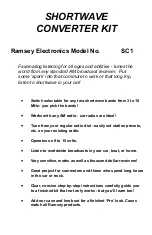
2
0
1
8
-0
6
8
Introduction
4
Introduction
4.1
Using This Manual
This manual describes how Fuchs absolute rotary encoders equipped with a
EtherCAT interface are integrated into a EtherCAT network.
The manual is valid for the following types of absolute rotary encoder:
■
ES*58-...EC...
■
EV*58-...EC...
■
ENA58IL-...B21...
The descriptions for the following topic areas cover all the important aspects for a simple
EtherCAT integration:
■
Integration into the EtherCAT interface
■
Configuration with TwinCAT
■
Activating EtherCAT communication
4.2
Absolute Rotary Encoders
Absolute rotary encoders output a uniquely coded numerical value at each shaft position.
Depending on the design type, the measured value is recorded via the optical scanning of a
transparent code disc (ES*58...EC..., EV*58-....EC...) or via a magnetic sensing principle
(ENA5 8IL...).
The maximum steps per revolution is 65,536 steps (16 bits). The multiturn version can detect
up to 16,384 revolutions (14 bits). As such, the highest possible resolution is 30 bits.
4.3
Communication via EtherCAT
4.3.1
General Information on Communication via EtherCAT
EtherCAT
®
(Ethernet for
C
ontrol
A
utomation
T
echnology) is a standardized, open fieldbus that
enables data exchange between PLCs, PCs, operating and observation devices, and also
sensors and actuators.
EtherCAT is suitable for both central and decentralized system architecture. It supports
master/slave, master/master, and slave/slave communication as well as the integration of
lower-level fieldbuses. With the "EtherCAT Automation Protocol", it also covers the factory level
and uses the existing infrastructure for this.
EtherCAT is an optimized industrial Ethernet technology and uses standard messages and
physical layers from the Ethernet standard IEEE802.3. The EtherCAT processes the messages
in an optimized way, resulting in quicker communication among the nodes and with the master.
Therefore, EtherCAT enables quicker reaction times compared to standard Ethernet.
EtherCAT also supports the Internet technologies. The "Ethernet-over- EtherCAT protocol"
transports FTP, HTTP, TCP/IP, and Co. without risking the real-time capability of the system.
Note!
More information on technical data, mechanical data, connection layouts, and available
connection lines for the relevant absolute rotary encoder types "ES*58-...EC...", "EV*58-
...EC...", and "ENA58IL-...EtherCAT" (B21) can be found in the corresponding datasheet.
Note!
The EtherCAT Technology Group (ETG) publishes various information brochures and an
EtherCAT product catalog (http://www.ethercat.org).









































